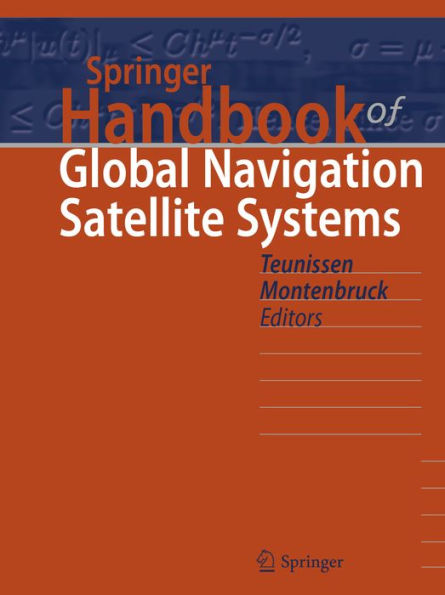This Handbook presents a complete and rigorous overview of the fundamentals, methods and applications of the multidisciplinary field of Global Navigation Satellite Systems (GNSS), providing an exhaustive, one-stop reference work and a state-of-the-art description of GNSS as a key technology for science and society at large.
All global and regional satellite navigation systems, both those currently in operation and those under development (GPS, GLONASS, Galileo, BeiDou, QZSS, IRNSS/NAVIC, SBAS), are examined in detail. The functional principles of receivers and antennas, as well as the advanced algorithms and models for GNSS parameter estimation, are rigorously discussed. The book covers the broad and diverse range of land, marine, air and space applications, from everyday GNSS to high-precision scientific applications and provides detailed descriptions of the most widely used GNSS format standards, covering receiver formats as well as IGS product and meta-data formats.
The full coverage of the field of GNSS is presented in seven parts, from its fundamentals, through the treatment of global and regional navigation satellite systems, of receivers and antennas, and of algorithms and models, up to the broad and diverse range of applications in the areas of positioning and navigation, surveying, geodesy and geodynamics, and remote sensing and timing.
Each chapter is written by international experts and amply illustrated with figures and photographs, making the book an invaluable resource for scientists, engineers, students and institutions alike.
This Handbook presents a complete and rigorous overview of the fundamentals, methods and applications of the multidisciplinary field of Global Navigation Satellite Systems (GNSS), providing an exhaustive, one-stop reference work and a state-of-the-art description of GNSS as a key technology for science and society at large.
All global and regional satellite navigation systems, both those currently in operation and those under development (GPS, GLONASS, Galileo, BeiDou, QZSS, IRNSS/NAVIC, SBAS), are examined in detail. The functional principles of receivers and antennas, as well as the advanced algorithms and models for GNSS parameter estimation, are rigorously discussed. The book covers the broad and diverse range of land, marine, air and space applications, from everyday GNSS to high-precision scientific applications and provides detailed descriptions of the most widely used GNSS format standards, covering receiver formats as well as IGS product and meta-data formats.
The full coverage of the field of GNSS is presented in seven parts, from its fundamentals, through the treatment of global and regional navigation satellite systems, of receivers and antennas, and of algorithms and models, up to the broad and diverse range of applications in the areas of positioning and navigation, surveying, geodesy and geodynamics, and remote sensing and timing.
Each chapter is written by international experts and amply illustrated with figures and photographs, making the book an invaluable resource for scientists, engineers, students and institutions alike.

Springer Handbook of Global Navigation Satellite Systems
1268
Springer Handbook of Global Navigation Satellite Systems
1268eBook (1st ed. 2017)
Related collections and offers

Product Details
| ISBN-13: | 9783319429281 |
|---|---|
| Publisher: | Springer-Verlag New York, LLC |
| Publication date: | 06/16/2017 |
| Series: | Springer Handbooks |
| Sold by: | Barnes & Noble |
| Format: | eBook |
| Pages: | 1268 |
| File size: | 50 MB |
| Note: | This product may take a few minutes to download. |
